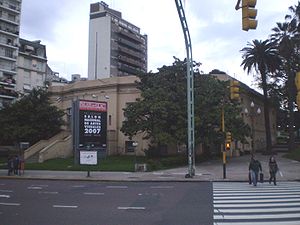
Palais de Glace
Encyclopedia

Belle Époque
The Belle Époque or La Belle Époque was a period in European social history that began during the late 19th century and lasted until World War I. Occurring during the era of the French Third Republic and the German Empire, it was a period characterised by optimism and new technological and medical...
building in the Recoleta
Recoleta
Recoleta is a downtown residential neighborhood in the city of Autonomous City of Buenos Aires, Argentina; it is an area of great historical and architectural interest, due, particularly to the Recoleta Cemetery located there...
neighbourhood of Buenos Aires
Buenos Aires
Buenos Aires is the capital and largest city of Argentina, and the second-largest metropolitan area in South America, after São Paulo. It is located on the western shore of the estuary of the Río de la Plata, on the southeastern coast of the South American continent...
, Argentina
Argentina
Argentina , officially the Argentine Republic , is the second largest country in South America by land area, after Brazil. It is constituted as a federation of 23 provinces and an autonomous city, Buenos Aires...
, located at 1725 Posadas street. Modelled on the Palais des Glaces in Paris
Paris
Paris is the capital and largest city in France, situated on the river Seine, in northern France, at the heart of the Île-de-France region...
, the building was designed by J.L.Ruiz Basadre and inaugurated in 1911 as an ice skating rink and social club.
The circular ice rink occupied a central room around which were arranged theatre-style boxes and rooms for social gatherings. The refrigeration plant was housed in the basement and on the first floor was a balcony, a cafe and organ. The building has a domed roof with a large central skylight which provided natural light for the skating rink below.
As ice skating became less fashionable in the following decade, and tango
Argentine Tango
Argentine tango is a musical genre of simple quadruple metre and binary musical form, and the social dance that accompanies it. Its lyrics and music are marked by nostalgia, expressed through melodic instruments including the bandoneon. Originated at the ending of the 19th century in the suburbs of...
gained increasing social acceptance, the Palais de Glace was converted into an elegant dance hall and played an important role in the promotion of this new dance phenomenon, initially opposed by the bourgeois elite
Bourgeoisie
In sociology and political science, bourgeoisie describes a range of groups across history. In the Western world, between the late 18th century and the present day, the bourgeoisie is a social class "characterized by their ownership of capital and their related culture." A member of the...
. Many well-known tango orchestras and dancers appeared here over the years but towards the end of the 1920s the venue went into decline and in 1931 the building was taken over my the local authority and given to the Ministry of Education and Justice.
From now on the building was used to house the National Office of Fine Arts and the annual Salón Nacional de Bellas Atres (in English: National Exhibition of Fine Arts) was held there from 1932 until 1954. Starting in 1931 the interior of the building was remodelled by the architect and artist Alejandro Bustillo
Alejandro Bustillo
Alejandro Bustillo was an Argentine painter and architect who left his mark in various tourist destinations in Argentina, especially in the Andean region of the Patagonia....
, to provide exhibition rooms whilst respecting the original design, and in 1934 three large murals were painted on the interior walls. In 1935 the exterior of the building was radically altered.
In 1938 an exhibition of television equipment was staged here and between 1954 and 1960 the building was used as a studio annex by the television station Canal 7. During this period the Salón Nacional was held at various venues including the National Museum of Fine Arts
Museo Nacional de Bellas Artes (Buenos Aires)
The National Museum of Fine Arts is an Argentine art museum in Buenos Aires, located in the Recoleta section of the city. The MNBA inaugurated a branch in Neuquén in 2004.-History:...
and the Argentine National Congress
Argentine National Congress
The Congress of the Argentine Nation is the legislative branch of the government of Argentina. Its composition is bicameral, constituted by a 72-seat Senate and a 257-seat Chamber of Deputies....
.
Since 1960 the Palais de Glace has once again hosted the Salón Nacional together with a range of other art exhibitions and musical events. In 2004 the building was declared a national historic monument.
External links
- Catalogue of Monuments
- See the current Palais' website: http://www.palaisdeglace.org/

